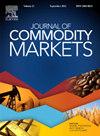经济、地缘政治和气候风险对商品波动的相互影响
IF 4.5
4区 经济学
Q1 BUSINESS, FINANCE
引用次数: 0
摘要
本研究采用分位矩方法来研究经济政策不确定性(EPU)、地缘政治风险(GPR)和气候风险如何影响商品回报波动。通过纳入相互作用效应,我们表明,在压力期间,忽略这些相互作用的模型低估了高达35%的波动性。分析揭示了不同波动机制的不同影响,转型气候风险加剧了市场波动,尤其是在动荡时期,而物理气候风险则表现出缓解作用。这些发现为商品市场的风险管理和政策协调提供了有价值的启示,突出了考虑正常和波动市场条件下相互作用影响的重要性。本文章由计算机程序翻译,如有差异,请以英文原文为准。
Interactive effects of economic, geopolitical, and climate risks on commodity volatility
This study employs a quantile moments approach to examine how economic policy uncertainty (EPU), geopolitical risk (GPR), and climate risks affect commodity return volatility. By incorporating interaction effects, we show that models ignoring these interactions underestimate volatility by up to 35% during stress periods. The analysis reveals varied effects across different volatility regimes, with transition climate risk intensifying market volatility particularly during turbulent times, whereas physical climate risk exhibits a mitigating effect. These findings offer valuable implications for risk management and policy coordination in commodity markets, highlighting the importance of considering interaction effects both normal and volatile market conditions.
求助全文
通过发布文献求助,成功后即可免费获取论文全文。
去求助
来源期刊

Journal of Commodity Markets
Multiple-
CiteScore
5.70
自引率
2.40%
发文量
53
期刊介绍:
The purpose of the journal is also to stimulate international dialog among academics, industry participants, traders, investors, and policymakers with mutual interests in commodity markets. The mandate for the journal is to present ongoing work within commodity economics and finance. Topics can be related to financialization of commodity markets; pricing, hedging, and risk analysis of commodity derivatives; risk premia in commodity markets; real option analysis for commodity project investment and production; portfolio allocation including commodities; forecasting in commodity markets; corporate finance for commodity-exposed corporations; econometric/statistical analysis of commodity markets; organization of commodity markets; regulation of commodity markets; local and global commodity trading; and commodity supply chains. Commodity markets in this context are energy markets (including renewables), metal markets, mineral markets, agricultural markets, livestock and fish markets, markets for weather derivatives, emission markets, shipping markets, water, and related markets. This interdisciplinary and trans-disciplinary journal will cover all commodity markets and is thus relevant for a broad audience. Commodity markets are not only of academic interest but also highly relevant for many practitioners, including asset managers, industrial managers, investment bankers, risk managers, and also policymakers in governments, central banks, and supranational institutions.
 求助内容:
求助内容: 应助结果提醒方式:
应助结果提醒方式:


